As an Amazon Associate CoffeeXplore.com earns from qualifying purchases.
Hojicha Latte Master Recipe for Perfect Creamy Flavor
Tired of weak, clumpy, or bitter homemade lattes? You want that cafe-quality experience at home.
A Hojicha Latte is a Japanese beverage made from roasted green tea powder. Its unique toasty, nutty flavor offers a comforting, low-caffeine alternative to coffee.
A perfect Hojicha Latte requires a base ratio of 2g (approx. 1 tsp) of high-quality Hojicha powder whisked into 60ml of hot water (180°F or 82°C), combined with 180ml of milk and your preferred sweetener. This guide will give you the master recipe. You will discover the secrets to a perfectly creamy, toasty, and delicious drink every time.
Quick Hojicha Latte Recipe Card (The Master Ratio)
For those ready to start right away, here is the master ratio for the perfect Hojicha Latte. This simple formula guarantees a creamy, toasty, and low-caffeine beverage every single time. It relies on a precise 1:3 ratio of Hojicha powder to its hot water base, which is then combined with your milk of choice.
- Prep Time: 5 minutes
- Servings: 1
- Calories: 80-120 (depends on milk/sweetener)
Ingredients:
* Hojicha Powder: 2 grams (approx. 1 level tsp), ceremonial grade recommended
* Hot Water: 60 ml (2 oz) at 180°F (82°C)
* Milk: 180 ml (6 oz) of oat milk (barista blend) or whole milk
* Sweetener: 1 tsp of maple syrup or brown sugar syrup (optional)
Instructions:
1. Sift 2g of Hojicha powder into a wide bowl.
2. Pour 60 ml of 180°F water over the powder.
3. Whisk vigorously until a smooth, dark concentrate forms.
4. Steam or froth 180 ml of milk with sweetener.
5. Pour the Hojicha concentrate into a mug, then gently add the frothed milk.
Mastering the Two-Stage Method: 7 Steps to Perfect Cafe-Quality Hojicha Latte
To achieve a truly exceptional, cafe-quality Hojicha Latte, we use the “Two-Stage Dissolution Process.” This expert method is the key to preventing clumps and unlocking the full, rich flavor of the roasted green tea. By first creating a smooth, concentrated Hojicha base before introducing the milk, you guarantee a silky texture and perfectly balanced taste. These seven steps break down the entire process, from precise measurement to the final, creamy pour.
1. Measure and Sift the Powder for a Clump-Free Start

Pin this genius hack to your ‘Low-Caffeine Drink’ board!
The foundation of a smooth latte is precision. This first step ensures every particle of the delicate Hojicha powder dissolves perfectly, preventing the dreaded clumps that can ruin the texture of your drink.
Materials Needed:
- 2 grams (1 level tsp) of Hojicha Powder (organic, ceremonial grade preferred)
- Digital Kitchen Scale (to ensure precise 2g measurement)
- Fine Mesh Sifter (or small tea sifter)
- Wide Whisking Bowl (Chawan or small ceramic mug)
Step-by-Step Directions:
- Place your whisking bowl on the digital kitchen scale and tare it to zero.
- Carefully measure 2 grams of Hojicha powder directly into the fine mesh sifter.
- Gently tap or shake the sifter to drop the powder into the bowl, breaking up any microscopic clumps (a crucial step, especially for older or less fine powders).
- Set aside the sifted powder and prepare the water.
Pro-Tip: Using weight (grams) rather than volume (teaspoon) ensures better consistency, as powder density can vary widely.
2. Achieve Optimal Water Temperature (Avoiding Bitterness)

Save this critical temperature guide!
The single biggest mistake in preparing Hojicha is using water that is too hot. This scientific approach to temperature control protects the delicate roasted flavor and prevents a scorched, bitter taste.
Equipment and Science:
- 60 ml (2 oz) filtered water
- Electric Kettle with temperature control or Digital Food Thermometer
- Small Saucepan (if using stove-top heating)
Temperature Strategy:
- Heat your filtered water to the ideal range: 175°F to 190°F (80°C to 88°C).
- Crucial Rule: Never use boiling water (212°F / 100°C) as this will scald the delicate roasted components, releasing bitter compounds and suppressing the nutty aroma.
- If using a standard kettle, bring water to a boil, then remove it from the heat and allow it to cool for approximately 60 seconds before measuring the temperature.
- Measure exactly 60 ml (2 oz) of water into a small jug or measuring cup for the base.
Expert Insight: The roasting process creates pyrazine compounds, which give Hojicha its smoky flavor. Excessive heat destroys these compounds and extracts unwanted bitterness.
3. Whisk the Hojicha Base (The Two-Stage Dissolution Process)
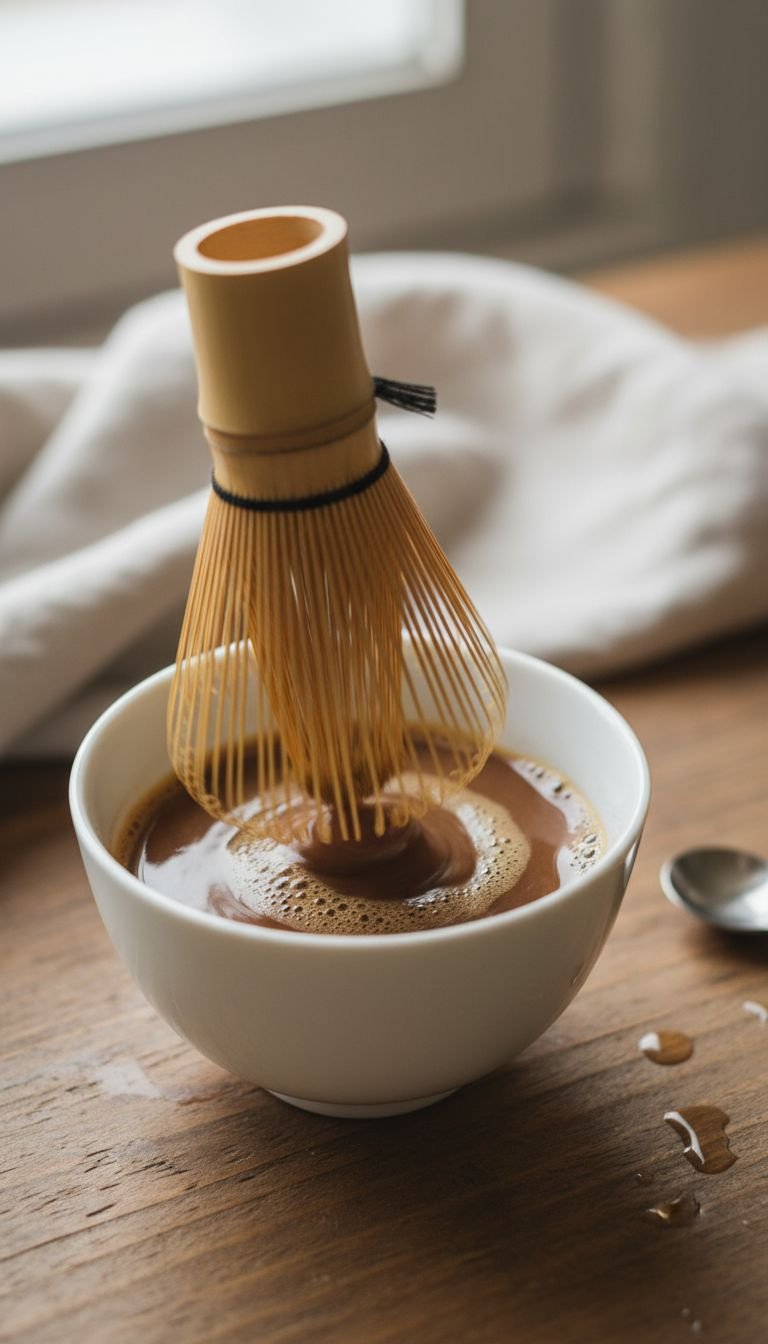
Save this whisking technique!
This is where the magic happens. By creating a concentrated Hojicha base, you ensure the powder dissolves completely, resulting in a smooth, sediment-free latte. The right tool and technique are essential.
Tools and Technique:
- Sifted Hojicha Powder (2g)
- Hot Water (60 ml / 2 oz, 180°F)
- Chasen Whisk (bamboo whisk) OR Electric Hand Frother
Whisking Steps:
- Pour the precisely measured 60 ml of 180°F water directly onto the sifted Hojicha powder in the bowl.
- Immediately begin whisking vigorously in a rapid ‘W’ or ‘M’ motion, using only your wrist, not your arm.
- Continue whisking for 20-30 seconds until a smooth, dark-brown concentrate with a thin layer of fine foam on top is formed. Do not stop until all clumps are gone.
- If using an electric frother, use it at the bottom of the bowl for 10-15 seconds until homogenous.
Lesson Learned: If using a Chasen, run it under hot water before use to soften the tines; this prevents snapping and improves whisking efficiency.
4. Froth Your Milk for Creamy, Barista-Style Texture
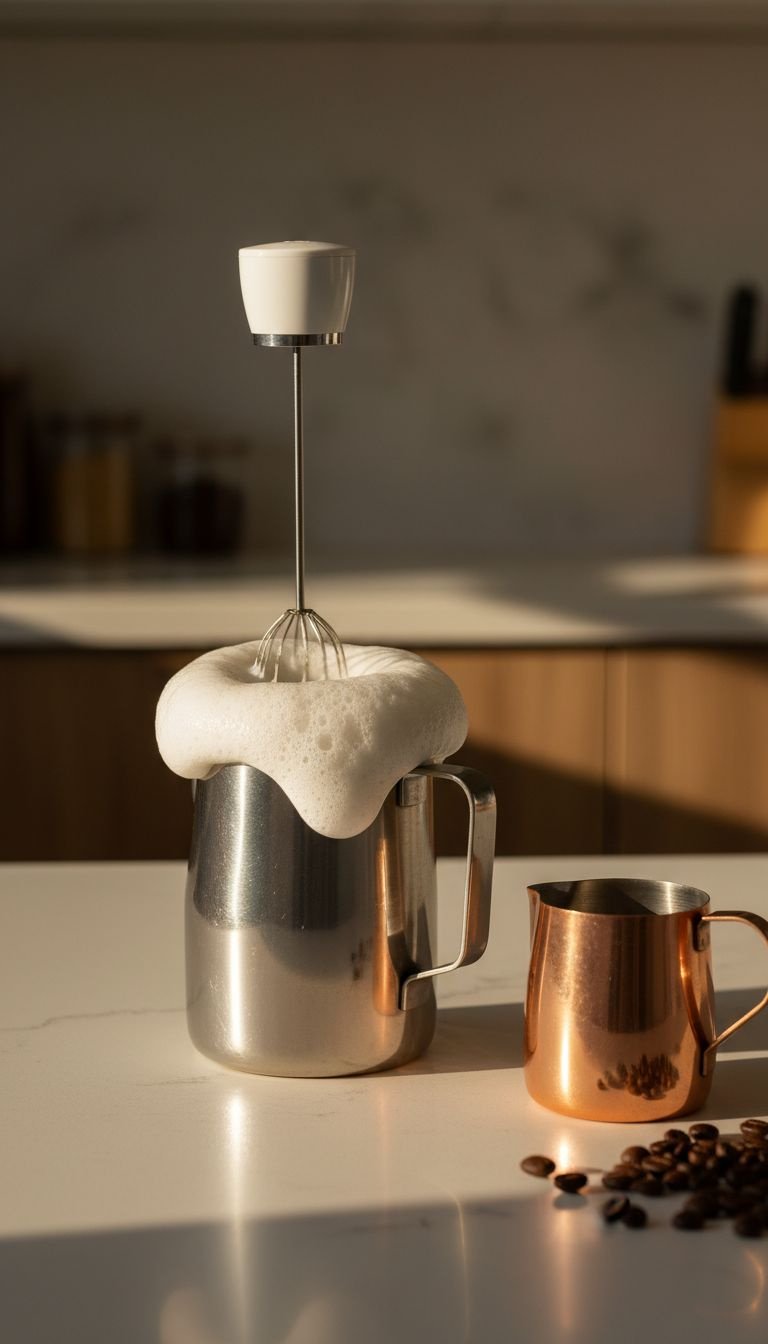
Save this clever organization idea!
The creamy texture of a latte is just as important as its flavor. Choosing the right milk and frothing it correctly creates the luxurious, velvety mouthfeel that defines a high-quality drink.
Materials Needed:
- 180 ml (6 oz) Barista-Blend Oat Milk (for best frothing) or Whole Milk
- Optional: 1 tsp Brown Sugar Syrup or Maple Syrup
- Electric Milk Frother OR Espresso Machine Steam Wand
Steaming and Frothing:
- If using a steamer wand, steam the milk to approximately 140°F–150°F (60°C–65°C). Do not exceed 160°F, which can scald the milk.
- If using an electric frother, add the milk (and optional sweetener) and run the cold or hot foam cycle until creamy microfoam is achieved.
- Optional: If using sweetener, dissolve it fully into the hot milk or, ideally, into the Hojicha base (Step 3) for the best flavor integration.
- Tap the milk pitcher gently on the counter to eliminate any large, unwanted air bubbles.
Pro-Tip: Barista-blend oat milk is consistently recommended by experts for its high fat content and emulsifiers, which create stable, non-separating microfoam ideal for Hojicha’s robust flavor.
5. Combine and Serve Hot (The Layered Pour)
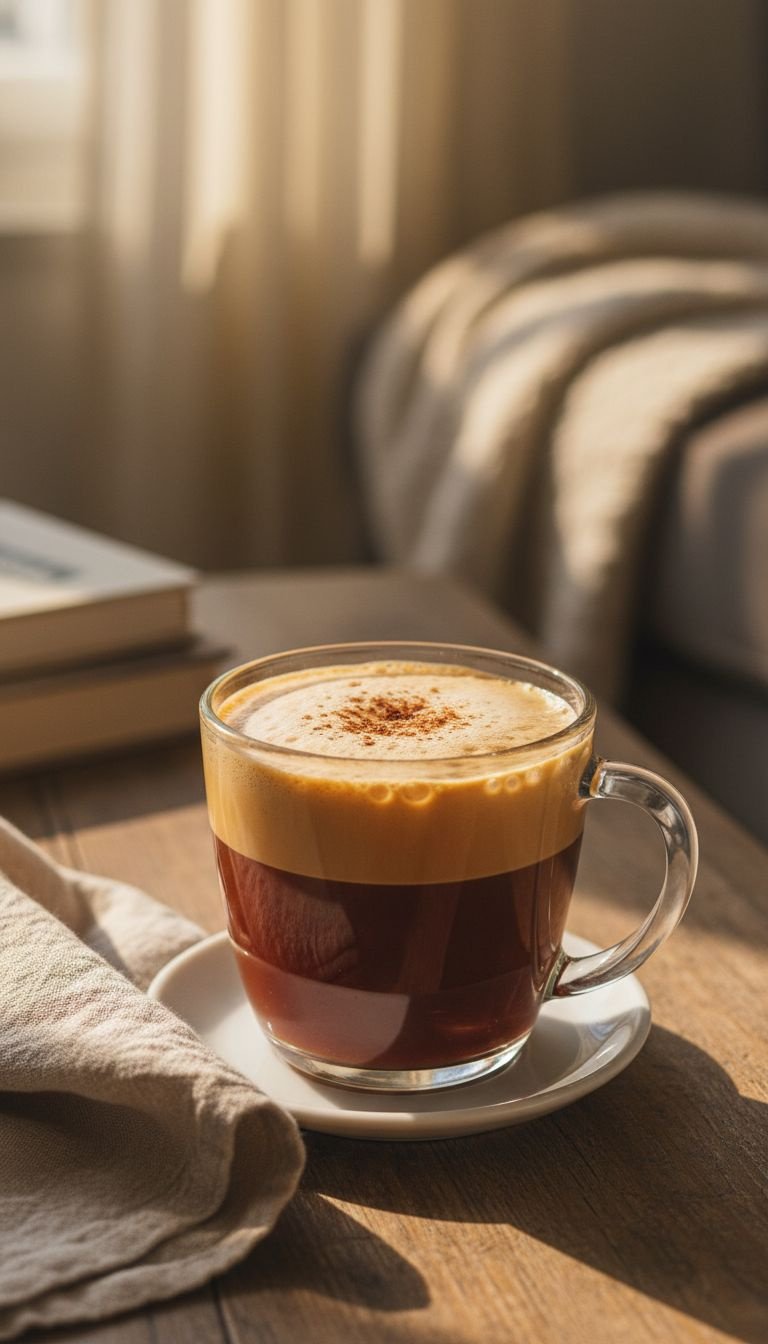
Pin this layered latte art inspiration!
The final assembly is all about presentation and creating that beautiful, inviting look. A careful pour results in an impressive layered effect that makes your homemade latte feel like a professional creation.
Presentation Elements:
- Hojicha Concentrate Base (from Step 3)
- Frothed/Steamed Milk (from Step 4)
- Serving Mug or Glass
- Optional: Pinch of Hojicha powder for garnish
Serving the Hot Latte:
- Pour the Hojicha base concentrate into your chosen serving mug or heatproof glass.
- Gently pour the frothed milk over the concentrate. For a dramatic layered effect, pour slowly onto the back of a spoon.
- Allow the foam to rise to the top.
- Stir gently once before serving, or leave layered for visual appeal and stir before drinking.
- Garnish with a light dusting of Hojicha powder or a small pinch of cinnamon, if desired.
Lesson Learned: If the milk is too bubbly (not microfoam), the layers won’t integrate smoothly; tap the pitcher harder before pouring.
6. Converting the Recipe to a Refreshing Iced Hojicha Latte
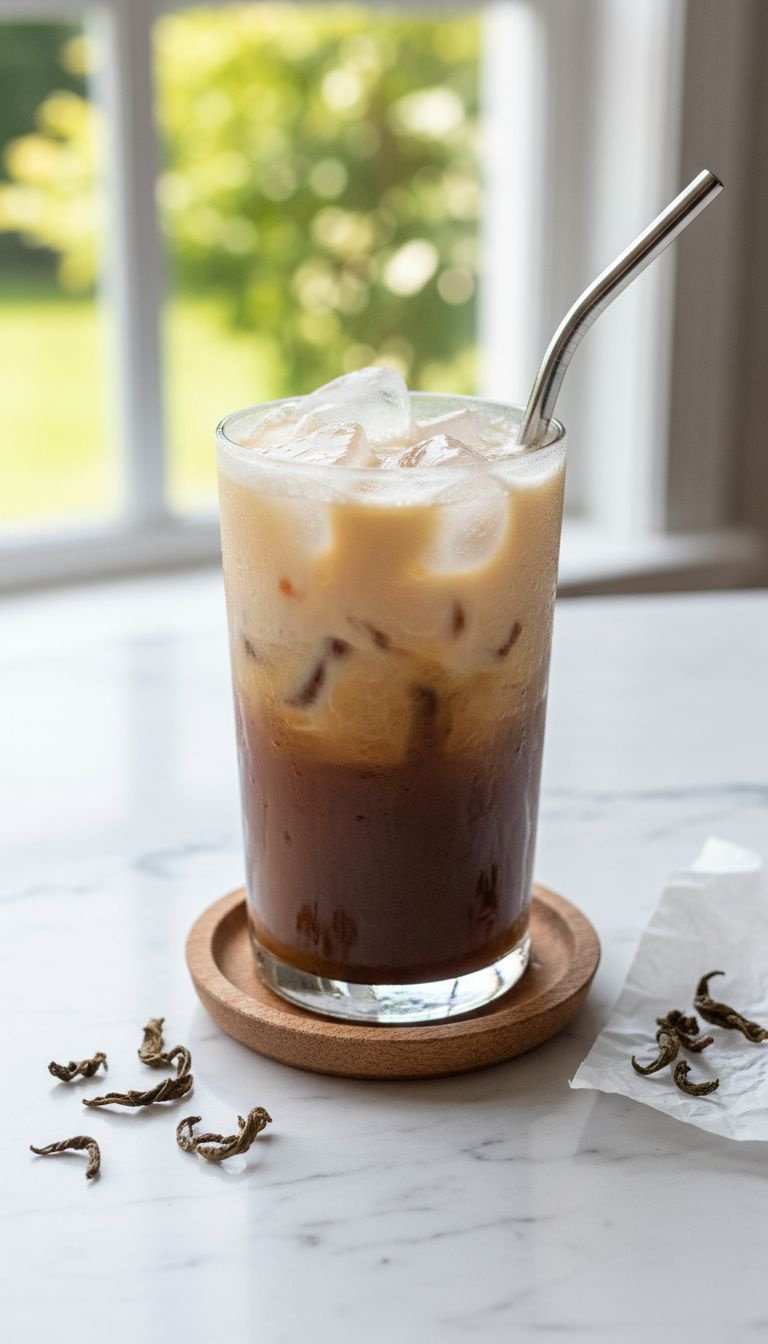
Pin this ultimate summer recipe!
The same master recipe can be easily adapted for a cool, refreshing summer drink. The key to a great iced latte is preventing dilution, which can quickly turn a flavorful drink into a watery disappointment.
Materials Needed:
- Hojicha Concentrate Base (from Step 3)
- Large, clear Ice Cubes (or Hojicha Ice Cubes)
- Cold Milk (180 ml / 6 oz)
- Tall Serving Glass
Iced Conversion Steps:
- Critical Cooling Step: After whisking the Hojicha base, transfer the concentrate to a small container and allow it to cool completely (ideally 5-10 minutes) before mixing. Do NOT add the hot base directly to ice.
- Fill your tall glass with large ice cubes. Large cubes melt slower, preventing dilution.
- Pour the cooled Hojicha concentrate over the ice.
- Add cold milk straight from the refrigerator.
- Stir thoroughly with a long spoon or straw before drinking.
Pro-Tip: For the strongest flavor, make Hojicha Ice Cubes by freezing leftover unsweetened concentrate. Use these instead of water ice cubes to avoid dilution entirely.
7. Advanced Flavor Pairings: Spices and Syrups That Enhance the Roast
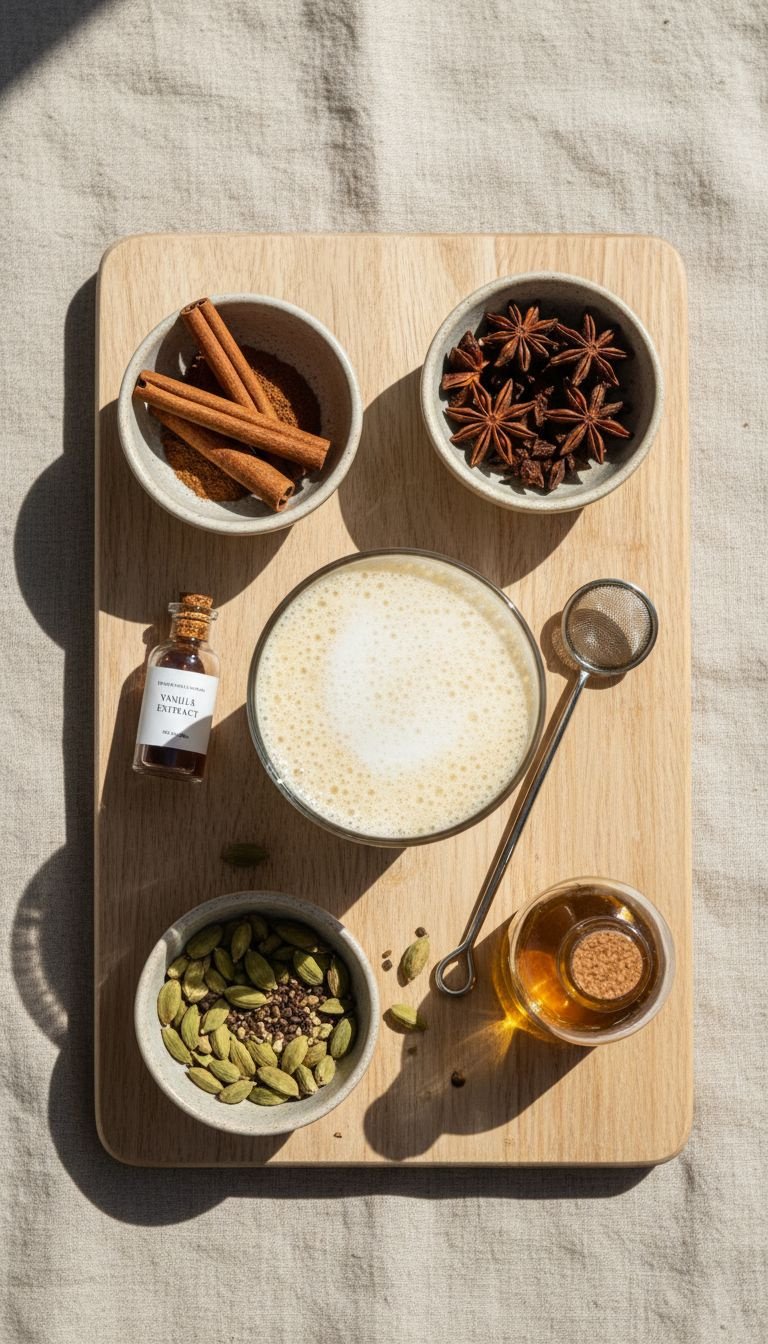
Save this guide to elevate your homemade lattes!
Once you’ve mastered the basic recipe, you can explore a world of creative flavor combinations. The earthy, roasted notes of Hojicha pair beautifully with warming spices and rich syrups, allowing you to customize your drink to perfection.
Flavoring Agents:
- 1/4 tsp Ground Cinnamon or Cardamom (use high-quality spice)
- 1/2 tsp Pure Vanilla Extract or Vanilla Syrup
- 1 tsp Brown Sugar Simple Syrup (for caramelized notes)
- Optional: A few grains of fine Sea Salt (to enhance sweetness and nuttiness)
Customization Directions:
- Spice Infusion: Add the ground spice (Cinnamon or Cardamom) to the Hojicha powder before Step 1, allowing it to sift and whisk directly into the base for maximum flavor release.
- Vanilla Boost: Stir in 1/2 tsp of vanilla extract or syrup after the Hojicha base is created but before adding the milk.
- Salt Enhancement: Dissolve a few grains of fine sea salt into the hot water base before whisking—this surprisingly enhances the roasted, nutty flavor notes.
- Syrup Control: For consistency, use high-quality simple syrups (brown sugar or maple) that dissolve instantly, adjusting the amount to suit your preference.
Pro-Tip: The roasted notes of Hojicha pair best with warm, earthy spices like cinnamon and cardamom, rather than citrus or sharp berry flavors.
Ingredient Deep Dive: Choosing the Perfect Powder, Milk, and Sweetener
The quality of your Hojicha Latte is directly tied to the quality of your ingredients. Understanding the differences between Hojicha grades, milk types, and complementary sweeteners is the key to unlocking an authentic and delicious flavor profile.
Hojicha Powder: Ceremonial vs. Culinary Grade
Ceremonial grade Hojicha powder offers the finest grind and most intense, pure roasted aroma, making it ideal for lattes where the flavor is the centerpiece. Culinary grade is often coarser and slightly less vibrant, best reserved for baking or blending into strong smoothies. Always prioritize powder explicitly labeled for lattes or beverages.
The Ultimate Milk Showdown: Oat Milk vs. Whole Milk
Barista-blend Oat Milk is the champion for Hojicha Lattes due to its natural sweetness that complements the roasted notes and its high-fat content, which produces stable, creamy microfoam without dairy. Whole Milk offers a traditional richness and excellent frothing capability but changes the flavor profile subtly. Avoid low-fat or thin milks, which often yield a watery texture.
The Best Sweeteners to Complement the Toasty Flavor
The smoky, caramelized flavor of Hojicha pairs flawlessly with sweeteners that possess deep, complementary notes. Maple Syrup and Brown Sugar Simple Syrup are highly recommended as they enhance the inherent caramelization of the roasted tea. Avoid white sugar, which provides only flat sweetness, or sharp, acidic sweeteners.
Troubleshooting Your Hojicha Latte (The Anti-Clump and Anti-Bitter Strategy)
Even with the best recipe, things can go wrong. These common issues are easily fixed once you understand the science behind them. Here’s how to solve the most frequent problems and ensure your expensive ingredients don’t go to waste.
Problem 1: Why Is My Latte Clumpy and Gritty?
The powder was not properly dissolved in hot water before adding the milk. Always sift the powder first (H3, Step 1) and use the correct temperature range (175°F-190°F). If clumps remain, use an electric hand frother instead of a manual whisk for higher shear force.
Problem 2: My Hojicha Tastes Scorched or Bitter
You used water that was too hot. Water above 195°F (90°C) extracts bitter, harsh flavors from the roasted tea compounds. Re-test your kettle or thermometer to confirm your water temperature is within the safe 180°F range. Low-quality or very old powder can also contribute to bitterness.
Problem 3: The Latte Is Watery and Lacks Creaminess
The powder-to-liquid ratio is incorrect, or you used the wrong milk. Ensure you are using at least 2g of powder per 8 oz of liquid (milk + water). Switch to a barista-blend milk (oat or whole milk) for better body and foam stability. For iced lattes, use less water in the base and ensure the concentrate is cool before adding ice to prevent dilution.
Hojicha vs. Matcha: The Ultimate Japanese Tea Latte Comparison
While both are popular Japanese green tea lattes, Hojicha and Matcha are worlds apart in flavor, color, and caffeine content. Understanding their differences helps you choose the right drink for the right moment. The main difference is that Hojicha is roasted, giving it a toasty, low-caffeine profile, while Matcha is unroasted, resulting in a vegetal, high-caffeine beverage.
| Feature | Hojicha Latte (Roasted Green Tea) | Matcha Latte (Unroasted Green Tea) |
|---|---|---|
| Caffeine Level | Very Low (5-15mg per serving) | High (30-70mg per serving) |
| Flavor Profile | Toasty, Smoky, Caramel, Nutty | Vegetal, Grassy, Umami, Slightly Astringent |
| Color | Reddish-Brown / Light Mocha | Vibrant Green |
| Best For | Evening, Relaxation, Dessert | Morning, Focus, Energy Boost |
| Origin | Lower-grade Bancha/Sencha, roasted | Shade-grown Tencha, ground |
The Science of Hojicha: Why It’s Low Caffeine and Rich in Flavor
The unique characteristics of Hojicha aren’t accidental; they are the direct result of a specific high-heat roasting process that transforms the tea leaves. This section explains the science behind its signature smoky aroma and naturally low caffeine content.
The Roasting Process: Birth of the Smoky Aroma
Hojicha is typically made from older Bancha or Sencha leaves/stems that are roasted over high heat (around 300°F-400°F or 150°C-200°C) until they turn reddish-brown. This roasting process dramatically alters the tea’s chemical makeup, most notably generating Pyrazine compounds, which are responsible for the comforting, nutty, and caramelized aroma we associate with Hojicha.
The Low-Caffeine Secret: Degradation of Catechins
The primary reason Hojicha has a significantly lower caffeine content than Matcha or standard green tea is that the high heat used in the roasting process degrades the caffeine molecules and many of the astringent Catechins. This intentional reduction leaves the Hojicha with a mild, soothing character that makes it ideal for evening consumption.
Key Takeaways: Your Quick Guide to Hojicha Latte Mastery
Mastering the perfect Hojicha Latte comes down to a few core principles. Keep these five rules in mind, and you’ll achieve delicious, consistent results every time.
- Precision is Power: Use a digital scale to ensure exactly 2g of Hojicha powder per serving.
- Temperature Control is Critical: Never exceed 190°F (88°C) water temperature to prevent bitterness.
- Always Sift and Whisk: Employ the Two-Stage Dissolution Process (sift, then whisk into hot water base) to eliminate all clumps.
- Choose the Right Milk: Opt for barista-blend oat milk or whole milk for the best texture and flavor synergy.
- Flavor Matters: Pair the natural roast with complementary sweeteners like maple or brown sugar syrup.
People Also Ask About Hojicha Latte
Is Hojicha Latte safe for pregnant women?
Hojicha Latte is generally considered safe during pregnancy due to its very low caffeine content (typically less than 15mg per serving), making it a safer alternative to most coffees and traditional teas. However, pregnant women should always consult their healthcare provider regarding daily caffeine limits.
How do I store Hojicha powder to keep it fresh?
Store Hojicha powder in an opaque, airtight container in a cool, dark place, or ideally, keep it refrigerated or frozen after opening. This protects the volatile roasted aroma compounds from oxygen, light, heat, and moisture, which rapidly degrade the flavor profile.
Can I use Hojicha tea bags instead of powder for a latte?
No, Hojicha tea bags are not recommended for a traditional latte. They contain steeped leaves which yield a milder, less concentrated flavor and a watery texture, lacking the intensity and creaminess achieved by whisking fine Hojicha powder into a base.
Does Hojicha powder contain any sugar or calories?
Pure Hojicha powder contains virtually no sugar and minimal calories (typically 2-3 calories per gram). The caloric and sugar content of a Hojicha Latte comes entirely from the type of milk and sweetener added.
Final Thoughts
The pursuit of the perfect Hojicha Latte is a rewarding ritual that elevates the everyday. By prioritizing precision in temperature, choosing the right ingredients, and mastering the two-stage whisking technique, you have the expertise to consistently recreate cafe-quality results at home. Now that you’ve mastered the technique, what is your favorite flavor pairing—a simple touch of vanilla, or a spicy hint of cardamom? Share your perfect Hojicha combination in the comments below! This recipe was last tested and updated in November, 2025.
Last update on 2025-11-19 / Affiliate links / Images from Amazon Product Advertising API

